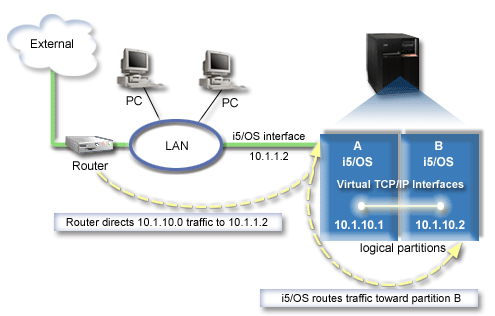TCP/IP routing method
Standard TCP/IP routing is used to route traffic to the virtual Ethernet network in the same way you define routing to any other LAN. This requires that you update routing information throughout your network.
You can also route traffic to your partitions through IBM® i with various routing techniques. This solution is not difficult to configure on the system but, depending on the topology of your network, it might not be practical to implement. The TCP/IP routing method supports both IPv4 and IPv6. The following figure shows an IPv4 network:

The existing TCP/IP interface (10.1.1.2) connects
to the LAN. The LAN is connected to remote networks with a router.
The virtual TCP/IP interface on partition B is addressed as 10.1.10.2 and
the virtual TCP/IP interface on partition A as 10.1.10.1.
In IBM i, if you turn on IP datagram
forwarding, IBM i will route the IP packets
to and from partition B. When you define your TCP/IP connection
for partition B, the router address must be 10.1.10.1.
The difficulty of this type of routing is getting
the IP packets to the system. In this scenario, you can define a
route on the router so that it passes packets destined to the 10.1.10.0 network
to the 10.1.1.2 interface. That works for remote
network clients. It also works for the local LAN clients (clients
connected to the same LAN as the IBM i platform) if they
recognize that same router as their next hop. If they do not, then
each client must have a route that directs 10.1.10.0 traffic
to the IBM i 10.1.1.2 interface;
therein starts the impracticability of this method. If you have many
LAN clients, then you must define many routes.
To configure virtual Ethernet to use the TCP/IP routing method, use the following instructions: